
- Organizational Design - Home
- Organizational Design - Introduction
- Organizational Design - Evolution
- Common Forms
- Factors Influencing
- Case Study 1
- Case Study 2
- Organizational Design - WorkSheet
- Case Study 3
Organizational Design - Quick Guide
Organizational Design - Introduction
Organizational Design is a sequential method of identifying the performing aspects and liabilities in a system, so that they can be re-aligned as per the needs of the company, such as current goals and implementing new business changes. It focusses on improving technical and interpersonal side of the workplace. Implementing an efficient organizational design leads to a more effective organization, a more focused workforce and a workplace of better productivity by improving internal operations, inter-departmental relationships, working efficiency, all of which leads to better productivity and customer satisfaction.
During the implementation of Organization Design, a management may enforce numerous strategic changes as per their strategy to deliver the desired results. In this process, there are chances of clashes between work-processes and the occasional trade-offs. Sometimes, there will be situations where the management realizes that they have to sacrifice smaller benefits to ensure larger benefits in the future.

Due to these reasons, changes in Organizational Design are always not as smooth as the management will like them to be. However, successful companies have managed to implement such changes with an eye on the big picture and have communicated their strategies with transparency to their employees, which has helped them to bring future-embracing changes in their structure without getting any negative press or reputation to their names.
Example
A notable example would be the Belgian giant, DuPont that decided to enter into the international market and diversify its business in 1921. To ensure that these ventures remain profitable, they implemented changes to many fundamental structures of their management, thereby bringing a new structure to their working, which has held them high through all the effects of the fluctuating global economy. This case will be explored in greater detail in a case study.
Designing changes in any organization is a step-by-step process and involves focusing on different phases of planning.
In the first phase, people develop a vision for their company for the future. Once thats done, they identify their goals and the areas that they need to bring changes in to reach these goals.
The next step involves drawing out a clear set of objectives and what changes to implement, so that these objectives are realized.
This is followed by a crucial phase called Organizational Grouping during which the management decentralizes their workforce and divides them into separate groups that take care of different departments with enough autonomy to take their own decisions, with clear and timely communication with interlinked departments.
President George H. W. Bush had once asked a friend to help him identify some pressing issues for the election campaign, who suggested that he go alone to Camp David for a few days and figure out what direction he wants to lead the country towards, an incensed Bush told, Oh, the vision thing".
This exposed his inability to articulate important policies in a concise manner. He was one of the few incumbent US presidents who didnt win a second term.
Can you guess why?
Defining Organizational Design
Organization design is a framework architecture for an organization according to which an organization runs its business. It structures the workforce and the management in the most efficient working method through which they can realize their companys mission statement.
A successful and comprehensive design process is defined by the holistic approach it envisions for the organizational improvement. To design such a framework that addresses all the vital areas of a company, the management will have to draw objectives that ensure the following −
- Business Growth Model
- Improved Efficiency and Profits
- Outstanding Customer Service
- Improved Process Management
- Improved Workforce Productivity
- Decreasing Operational Expenses
- Improved Employee Engagement
Based on this framework, work is deployed, teams are formed, responsibilities are delegated and core values are implemented. As a result of this, high-quality output is produced, which is then offered to the clients. Following this chain of operations for every project ensures trust, quality-assurance, time-efficiency and more business.
However, unlike what many people assume, there is no particular super-design that fits all. In fact, companies have lost their fortunes and brought severe losses upon themselves in chasing after the elusive formula that will set everything in order for them. They kept implementing repeated changes in their organizations structure, but didnt end up improving their business.
Organizational Design - Evolution
Many people mistake Organization Design with Organizational Structure. In this chapter, we will understand the difference between both.
Organizational Structure
Organizational Structure is related to mapping out the different departments of an organization and the different teams working in each department, their hierarchical order, their goals and objectives. It also illustrates the roles and responsibilities given to different responsibilities.
A typical Organization Structure illustration looks like the following illustration −

Organizational Design
On the other hand, Organizational Design is related to aligning functions, processes, strategies, responsibilities and roles to different members of team and departments within the context of the various processes and products that the company produces.
What are Organizations?
When asked to imagine an Organization, people tend to picture a big glass building in a big campus with state-of-art facilities, bright corridors and teams upon teams of people working on different floors. It brings a surprised look in their eyes when they are told that every one of them has worked in an organization irrespective of the fact that they have ever stepped inside an office or not in their entire lives. If you are surprised too, then you are in a good company, because people relate to organizations with names like UNO, World Bank.
This issue arises from a fundamental misunderstanding in the meaning of the term Organization. We know that organizations consist of people working in big buildings. However, it is interesting to think if the buildings themselves are a part of the organization, even if the company owns it.
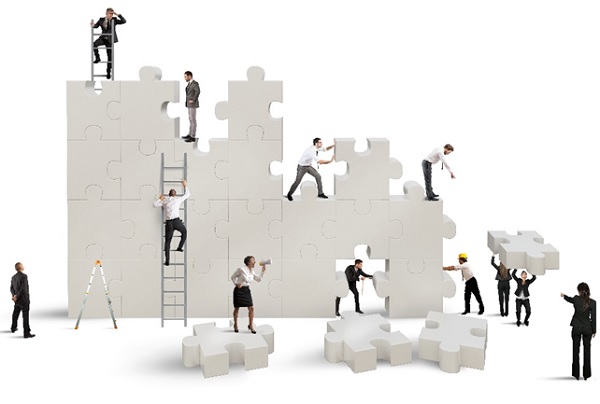
The answers to such questions were answered up to a great extent by Jim McNamara, who said that an organization in its most basic definition can apply to a single person too. According to him, an organization is either a person or group of people with an organized approach to complete an individual or collective goal with either an individual reward or collective reward in expectation.
Mission and Vision
The mission of any organization is identifying and conceptualizing the common purpose that binds the team-members together as one enterprise. This mission statement is often shared between members of the company and stakeholders to make them aware of the purpose and objectives of the organization.
There is a difference between Mission and Vision, though.
Vision − A Vision or Vision Statement tells what an organization should achieve and be in (n) years. It is related to trying to accurately predict the future of business and make preparations from now on. It tries to set a benchmark that the organization is supposed to achieve in a given number of years. Companies without a vision are perceived as self-centered who are resistant in adopting to change with passage of time.
Mission − In simple words, a Mission or Mission Statement explains what an organization does as its basic function. A Vision Statement tells what an organization should achieve and be in (n) years.
For example, many companies, most notably Nokia, faced bankruptcy due to their being too fixated on their present success to design a framework for the future.

Business Strategy
While the vision statement explains where the company should be headed in (n) years, business strategy is all about getting the business there. Strategy need not be long-term planning only; it may be short-term too and represents the methods through which a companys vision is realized.
Business Strategies decide the products and services that an organization will produce, the choice of technologies using which the products and services are designed, the development of these products, their pricing, marketing and distribution. It also involves finding competitive ways to counter rival companies.

Organizing and Resourcing
Once the organization draws out a mission and vision statement and finalizes a strategy on how to achieve these, the managers start to draw the framework, delegate responsibilities and recruit people as valuable resources and train them to deliver on objectives. The HRs take over these responsibilities after deciding upon the cost to the company (CTC) and the other motivation-oriented performance incentives.
Execution
Once the resources have been recruited, they are provided intensive training into the products and services and are inducted into their jobs. Their performances are subject to periodic informal reviews, during which their supervisor will identify issues in their working style and guide the employees, so that they can address these issues.
Review and Evaluation
After the probation period, during which the newly appointed recruits are kept under guidance-driven observation, they will be subjected to a periodic formal review process, during which their performances will be evaluated and feedback will be shared.
External Environment
In todays world of globalized business-dealing, no company can afford to operate in strict silo structures. Every company has to keep a tab of its working process. It needs to keep conducting reviews and scans to its working environment to see what further improvements it can bring in its workforce.
Organizational Design - Common Forms
Some of the most common strategies along which Organizational Grouping is done are behavior, function, product, customer, market and matrix. People are assigned teams based on these lines of functioning and are given instructions and their objectives and the managers are entrusted with the successful implementation.
After delegating work to different departments, the management then decides the hierarchy of reporting of the departments and selects the ones whose managers will report to them directly regarding progresses and areas of concern. All these types of organization represent a structure for an organizations design, where there is a clear chain of hierarchy and flow of communication.
Some of the most important design models are given below −
- Functional Organizational Design Model
- Geographical Organizational Design Model
- Product-oriented Organizational Design Model
- Market-oriented Organizational Design Model
- Matrix Structure Organizational Design Model
Let us now discuss in detail each one of these design models and see how they help organizations in their functioning.
Functional Organizational Design Model
Organizations that implement the functional model of organizational design divide their functioning into different fields. For example, there will be different boxes for different departments like marketing, finance, sales, legal, R&D and HR, etc. These departments will have their own separate board-level departments and sub-departments. This structural arrangement is reminiscent of the military line of command, where a strict pyramidal hierarchy and chain of action was observed.
The size and sub-divisions of each department varies according to the business needs. For example, if it is a law firm, their legal department will be more populated and sub-divided as compared to their R&D Department. Some organizations merge their Sales Department with the Marketing Department, so that the managers can work in-sync and bring ideas that support each others functioning.
Functional organizational structures are best for self-contained working units, such as a small company or a freelance-assignment team. The downside to this structure is that because of the strict hierarchical framework, issues tend to escalate to the vertical reporting authority, rather than getting sorted out by mutual understanding between two lateral units.
A typical functional organizational structure would look like this −
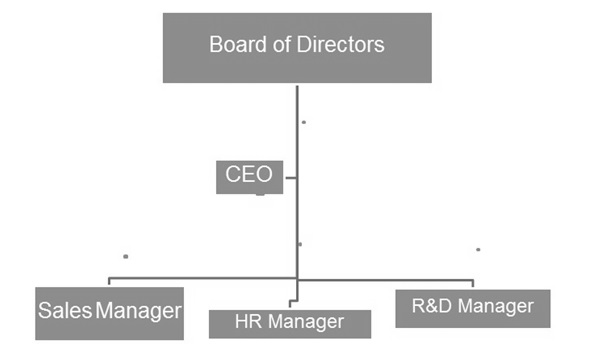
Geographical Organizational Design Model
As long as organizations remained localized, it was considered that the functional design is best suited for running business. However, when companies expanded and started operating beyond international boundaries, there was a need felt for a globalized model, which considers all the geography-influenced factors like local festivals, culture, communication style, way of conducting business, etc.
Example
A boss is a very formal, distant and authoritative figure in Russia, unlike the team player bosses that are the norm in the USA. To address such issues, multinational organizations started adopting to a geographical organizational structure.
Geographical organizational structure is tailor-made to suit the workings of an organization which has business presence in different countries and wants to understand the native culture of that place in order to understand its customers better. In this model, the top management employs local decision-makers to implement plans suited to local sensibilities. However, there is a potential issue with the usage of this organizational model by a company, which wants to have a global brand identity and has strong core values that it wants to be practiced in all cultures. In such situations, friction often arises between the regional offices and head office.
A typical geographical organizational structure would look like this −
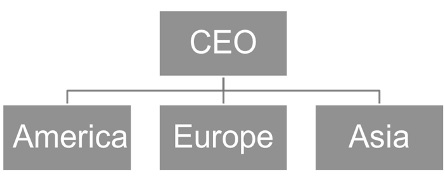
Product-oriented Organizational Design Model
In such models, the organization designs itself are based on its products. For example, a company that manufactures domestic electrical appliances may divide its business model on its prime-selling products, such as fans, water pumps, etc. Each product will have its own set of operations, employees, offers, etc.
This model works best in organizations that provide entrepreneurial opportunities to people with good business ideas. These people are made managers and an entire unit is assigned to them. In such a competitive environment, where different product lines are being run by separate teams dedicated to its marketing, promotion and sales; rivalry is sure to develop. This rivalry is healthy for business. However, if not nurtured in a healthy way, it can lead to bitter conflict after a particular stage.
A typical product-oriented organizational structure would look like this −
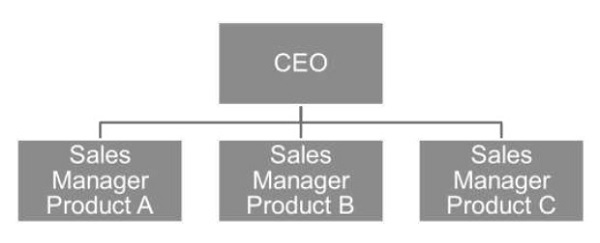
Market-oriented Organizational Design Model
In a market-oriented organization model, the focus of the company is in addressing the needs of the customers, as opposed to manufacturing products and creating the market for them, which the food industry often does. These models revolve around the logistics of serving a small number of customers, who can give them the business they need to be profitable. In such cases, it is very often to find an entire plant dedicated to manufacturing just a single line of products.
A few notable examples of organizations that adopt this model are from the automobile industry. Companies like BMW, Ferrari, Ducati, etc. have a niche customer base. These companies cater only to their customer base. The less number of customers gives a good opportunity for the sales managers to build strong business relationships with their clients. The customers also appreciate the personalized touch and enhanced customer service.
Such models work best when high quality assurance is given and the business growth depends more on interpersonal skills and relationship-building, as opposed to heavy advertisements and promotion.
A typical product-oriented organizational structure would look like this −
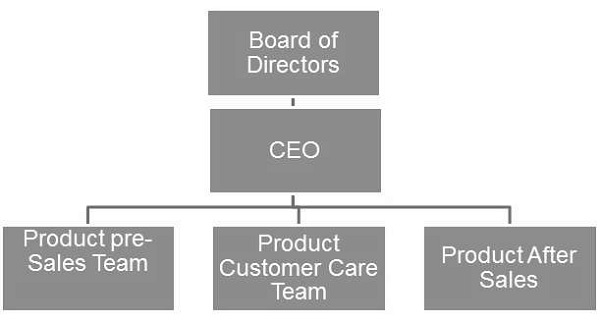
Matrix Structure Organizational Design Model
Matrix Structures are used when there is a high demand from the customers as well as a fundamental need to ensure efficiency and bureaucracy. This structure is used when projects employing many people are implemented and the clients want one organization whom they can entrust for the successful implementation of their plan. A few such sectors are construction, architecture, civil engineering, etc.
In this model, an employee reports to two bosses at the same time − one, an immediate supervisor and the other one the manager of the process. This results in role conflict and authority-related issues. If the supervisor and manager end up giving two conflicting or opposing instructions, then the employee gets stuck between two authorities.
A typical Matrix organizational structure would look like this −
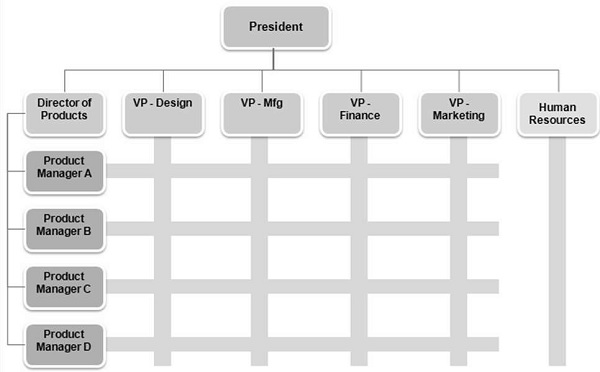
Conclusion
In spite of these different organizational models, companies dont have to stick to just one organizational model for all their businesses. In fact, many multinational companies implement product-oriented organizational design models in one country, whereas operating on a matrix model in some other country. Successful companies manage to find scopes of usage of all these models in different places and processes.
Factors Influencing Organizational Design
In other words, any company should adopt an organizational design that would serve its strategic purpose, instead of it being the other way round. For example, if a bike-manufacturing company wants to expand its business into sports goods and apparel, then the resources that will be needed for this will definitely impact the companys organizational design.
If the company was operating in a market-oriented organizational design structure, now it will have to adopt a product-oriented organizational design model. If it is planning to open offshore units, then it will have to adopt the geography-oriented organizational business model or else they will end up selling baseball bats in India and duke balls in the US.

To design a smoothly-functioning, efficient organizational design, the managers have to take a lot of factors in mind. Not only do they have to consider the clients and business side, but also the implementation too. The most important factor is the company vision. Depending on what the company wants to achieve, the managers will design objectives that the employees will adhere to while working.
This combination of strategy and implementation is crucial in ensuring success and business growth for companies in the long run. Organizational strategy can be defined as the Articulation of a Vision. During making these strategies, companies consider the competitive position they hold on the table.
Organizational Design - Case Study 1
Let us take a look at a case study which is named as − The Perfectionism of Larry Wells. Larry Wells, a successful businessman and a good negotiator had acquired a major retailer after seeing good business potential in it. Through his excellent managing skills and hard work he could use all his experience of business and start a profitable venture. When the business grew, he employed more and more staff to keep up with the demands at the workplace. However, he had a strictly confidential manner of managing the operations.
Being the manager of the company and the owner of the business, he kept the dealings and numbers close to his chest. His hesitation in sharing details about the business extended to all the managers, even directors of the company. Despite requests from the staff to trust them with decisions and details, he wouldnt divulge details which he thought only he should be privy to. Because of the lack of autonomy among managers of different departments, there were many areas on which they couldnt take timely decisions, and had to wait for Larry to give them his attention.
As business was expanding, this process of working made Larry lag behind all his competitors soon. All important decisions were put on hold till he could spare time for it. This method of pulling all the strings himself had ensured high quality of output in the initial stages, however dealing with every situation personally was disastrous time-management.
The clients who had given more business to Larrys company, after being impressed by the quality of output seen during the companys initial years, began looking for faster and more efficient service-providers. Ultimately Larrys company was sold out to another big organization, never realizing the full potential it had in its initial years.
Pitfalls of Micro-Managing Model of Business
Micro-managing resources is often the most common pitfall that first-time managers fall into. Because the project is new and the experience of managing is also first-time, a new manager feels the pressure of impressing his seniors by delivering excellent output, so that he can justify the managements decision of promoting him. This approach may appear fine to begin with, when the manager tries to get a first-hand experience of the process and tries to understand its functioning. However, when the work starts to expand and additional efforts are needed to keep the efficiency going, the company will hire more resources to keep up with the demand.

If the manager does not give up his micro-managing nature during this time, he will keep the entire team held up for him to take the final important decisions and steps. He will stall all other processes and departments while inspecting the progress of one department, which will cost the entire team a lot of time.
At this stage, a manager needs to stop micro-managing and allow freedom of functioning and autonomy to his team and trust them to come up with ways to handle any situations that may arise in his absence.
Organizational Design - Case Study 2
In this chapter, we will take a case study of one of the worlds largest cola maker, Coca Cola, to understand the importance of Organization Design.
How Coca Cola Fizzled Out on Globalization
An infamous example of a big corporation facing disastrous consequences from making frequent shifts in its organizational designs is Coca Cola. Years ago, when globalization seemed like an indispensable business strategy, the-then CEO of Coca Cola, the late Roberto Goizueta had stated on record that there was no demarcation between global and local any longer, ushering in his tagline − Think Global, Act Global.
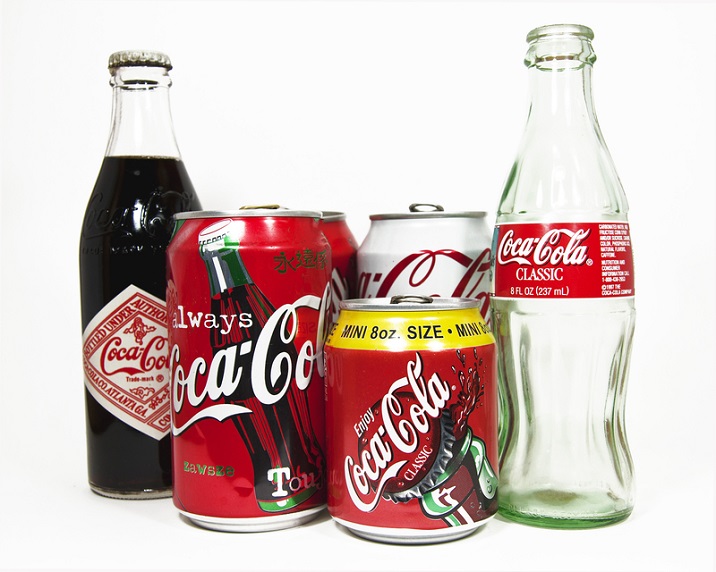
This led to an unprecedented degree of globalization and standardization in the business functioning of the company. Within a couple of years, Coca Cola was generating a much larger share of its revenues in offshore locations. During these years, it was generally thought that Coca Cola has finally hit upon the most magical formula that of success. However, this success was short-lived, and with the Asian crisis at the beginning of 1999, Coca Cola had lost more than 70 Billion Dollars.
The next in line, CEO Douglas Daft took over and introduced an aggressive shift in the opposite direction. His mantra was − Think Local, Drink Local. However, that reshuffling and restructuring of the organizational working model also failed, as people had gotten into an established way of working. This change of strategy brought in an even poorer run and started a period during which Coca Cola saw some of its worst revenues since the time of its setting shop. One of the biggest reasons behind this global debacle was that with the frequent changes in working structure, the line of communication and the hierarchy of working got affected. Employees couldnt keep a track of the different responsibilities they were handed after every change and this hampered their overall performance. This lead to confusion, cynicism, and job-insecurity in the minds of the employees.
What Experts Say?
After studying the strategy maps of hundreds and thousands of organizations, experts now confirm that there is no single organization that can claim to implement a perfect structure to all of its operations. In short, an Ideal Organizational Design Model is a myth.
Organizations, now much wiser after their disastrous past experiences, have now stopped aiming for a perfect design and have instead started focusing on a work-plan that helps them run a large organization harmoniously, while avoiding any large conflicts between its numerous departments.
Managers now believe in sending out clear design objectives to their team members, which ensures a different approach to managing resources and implementing business strategies. This minimizes job ambiguity and enhances focus towards work. They have realized now that its futile trying to work towards developing a framework that exploits the similarities between different countries. They now focus more on maximizing their output by modifying their business model and managerial style to accommodate the difference between various countries.
Organizational Design - WorkSheet
Sometimes, the best way for a manager to determine the ideal organizational design model for his process is to determine the strategies that he employs to ensure that his team members achieve their goals.
The following worksheet is designed to identify the different components of an organization that are taken into consideration while designing an organizational model that best suits the company.
1. Which type of business models you rate highest? Why?
a. Family-owned Business
b. Multinational Organization
c. Multinational Company
d. In your own company
Answer:
2. Which business sectors would you like to work in? Why?
a. Journalism/Media b. Transport & Tourism
c. Construction d. Pharmaceutical
e. Automobile Manufacturing f. IT Sector
g. Food and Drink h. Banking and finance
Answer:
3. Select statements matching operational purpose of elements in Side-A:
Statements:
- Finished products are sold here.
- Faulty products are mended here.
- An organizations main office.
- Goods are stored here.
- Good are made here.
- Goods are sent to customers from here.
- People make sales calls here.
- A company partially owned by another company
| Match Side - A | Match Side - B |
|---|---|
| a. Factory / Plant | |
| b. Service Center | |
| c. Head Office | |
| d. Distribution Center | |
| e. Branches | |
| f. Subsidiary | |
| g. Warehouse | |
| h. Call Centre |
4. Complete the following sentences with words given below:
a. The earnings a company made in a fixed period from sales is called _______
b. The net earnings of a company after deducting costs is called ______
c. Employees of a company working in a particular country called the _______
d. The percentage contribution of a company in sales in given market _______
e. The monetary value of a companys share _______
Words: Share Price, Workforce, Profit, Turnover, Market Share
5. What do the following departments do?
- Human Resources Department:
- Research & Development Department:
- Customer Service Department:
- Sales and Marketing Department:
- Logistics Department:
- Administration Department:
- Legal Department:
- Finance Department:
- Production Department:
- Public Relations Department:
- Information Technology:
Download Try-it yourself sheet.
Organizational Design - Case Study 3
In this chapter, we will do a case study which is titled as − How DuPonts Organizational Design Worked?
Founded in 1802, DuPont started out as a chemical-products manufacturing company and became one of the leading gunpowder-manufacturing companies for the US Army during the first World War. Towards the beginning of the 19th century, DuPont realized that unlike most other companies of that time, their company was still operating on the family-business model. However, just like many of their competitors, they also understood that they had grown beyond the ability to be managed by a single family.
At this time, they decided to diversify from a chemical-product manufacturing company and started acquiring new plants. The three DuPont cousins let go of their family-business model and started to do project management. They started to divert the entire company business from being in the explosives market to making a name for themselves as an emerging consumer and technology service provider.

Instead of gunpowder, they wanted to get into production of other chemical products like −
- Paints
- Dyes and
- Artificial Fabrics
As this was quite a drastic shift in business markets, DuPont had to make sure that their operations remain profitable. To address this need, they implemented a fundamental organizational restructuring. This restructuring involved getting the extremely centralized working model of DuPont getting increasingly de-centralized and autonomic in its functioning and decision-making.
They completely replaced the top-heavy hierarchical model, where only a few were authorized to take decisions and organized it on the model of line and staff, where there was a supervisor with enough authority to take decisions and carry the work ahead. Core functional departments were identified.
There were several departments that were then given their own separate −
- Decision Makers
- Managers
- Sales Teams
- Research & Development Wings and
- Support Teams
This managerial structure was quite new and untested during that time and it is no wonder that the organization had to go through some major shift in their thinking process about how business is done. However, with such a balanced and well-managed structure this organization managed to face decades of crisis like the Great Depression, the Second World War and others, till the economy swung around favorably, leading to the prosperous years of 1950s.
DuPont managed to achieve all the success they could by having a clear vision, taking timely decisions and allocating resources effectively. It is hard work and persistence paid off, especially with the success of nylon. The other companies, who were all skeptical about this de-centralized approach, were now falling head over heels in adapting to this new organizational model.
Conclusion
Adopting suitable organizational design structures has helped companies break the barriers of cultures and nationalities, which helps them do business with people all across the world and get global customers.
In todays competitive world, where companies constantly strive to perform better with each passing quarter, understanding the ideal organizational design for a particular working strategy is the most fundamental requirement for any company.
A few other factors that also influence a companys decisions are listed as PESTLE, which is an acronym for −
- Political Factors
- Economic Factors
- Social Factors
- Technological Factors
- Legal Factors
- Environmental Factors
An organization may choose to run its business in a functional manner, or could have a product-oriented approach. However, as long as it has a clear mission statement, the managers must try to build a framework where clear flow of communication is made possible. Organization Design fulfills this function globally.